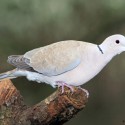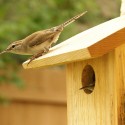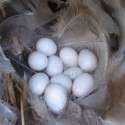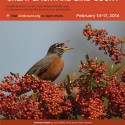 Photo ©
Keith Williams
Photo ©
Keith Williams

Be On the Lookout!
As the breeding season gets underway in the southern and western parts of the country, we are asking you to be on the lookout for Eurasian Collared-Dove nests this year. As you may be aware, a few Eurasian Collared-Doves were introduced to the Bahamas in the 1970s. They made their way to Florida by the 1980s and then rapidly colonized most of North America, especially areas converted to agriculture and urban uses. However, 30 years later, we still know very little about their breeding habits in North America.
In warmer regions, Eurasian Collared-Doves can nest year round, which may help explain their success as colonizers. But many questions remain unanswered, such as where, how often, and how successful is its breeding? Is there any change in its breeding strategies in this new range? And what are its effects on native species, particularly other doves?
If you find a Eurasian Collared-Dove nest, please report it to NestWatch. Eurasian Collared-Doves build a platform nest similar to that of our native Mourning Doves. The key to telling these two doves apart is the black crescent on the nape of the Collared-Dove’s neck, which is absent in the Mourning Dove. Be our eyes on the ground, and help us describe the species’ breeding biology in its newly colonized range!

Know Your Neighbors: Wrens
Have you had little brown birds nesting in your flower pots, your garage, or your nest boxes and didn’t know what they were? The wrens are often found nesting near people, and some folks may confuse their new neighbor for another wren species, or an altogether unrelated species. Here, we help clear up these “little brown jobs” so you can know your neighbors a little better.
Carolina Wren vs Bewick’s Wren
Both the Carolina and the Bewick’s Wren have a white stripe above the eye and are about the same size. While the Carolina Wren is an eastern bird and the Bewick’s has a more western distribution, their ranges do overlap in Texas, Oklahoma, and Kansas. In these states, look for a warm buffy belly on Carolinas and a pale grayish belly on the Bewick’s. The Carolina Wren also tends to be more reddish overall and does not flick its tail up and sideways like the Bewick’s Wren consistently does.
House Wren vs Winter Wren
These small plain wrens may look and sound alike, but you can distinguish them rather easily. The Winter Wren is our smallest wren, and is darker than the House Wren. Winters also give the impression of having just a short stub of a tail, held high, and a slightly more pronounced stripe above the eye. House Wrens are ubiquitous throughout most of the U.S. (the third most common bird reported to NestWatch in 2013!), whereas Winter Wrens typically breed only in Pacific Coast states, the Appalachians, and the far northeastern states (New York, Vermont, New Hampshire, and Maine). For most of us, Winter Wrens are usually just seen, you guessed it, in the winter.
While you certainly may find other species of wrens nesting in your yard, like the Cactus Wren or the Rock Wren, you will usually be able to distinguish these wrens by their unique habitat and plumage. Other lookalikes, like the Wrentit, Brown Creeper, and Bushtit, are superficially similar but unrelated to wrens. The next time you think you might have a wren nest, use our All About Birds page to browse the wren family, Troglodytidae (meaning “cave-dweller”), and compare songs, nesting habits, and range maps.

Tree Swallows Share Nest
NestWatcher Ian Stewart discovered something unusual in a nest box in Greenville, Delaware, this past season. Two female Tree Swallows laid their eggs in the same box, for a whopping total of 10 eggs! Instead of abandoning this full house, both females stayed to incubate the eggs and feed the young. Because both adult females were banded and captured in the box, we can say with certainty that they both helped to rear the young.
All 10 eggs did hatch, although the last one was one or two days later than the others and did not make it. Several weeks later, nine baby Tree Swallows fledged from this nest box, a remarkable outcome for a nest that, under different circumstances, may have been abandoned by both females. See more photos from Ian here. While you’re there, share your own photos and stories about the wonderful birds that you met while NestWatching.

Join the Great Backyard Bird Count!
Mark your calendar. The Great Backyard Bird Count (GBBC) is coming February 14–17. Anyone anywhere in the world can count birds for at least 15 minutes on one or more days of the count and enter their sightings at BirdCount.org. The information gathered by tens of thousands of volunteers helps track the health of bird populations at a scale that would not otherwise be possible.
In North America, GBBC participants will add their data to help define the magnitude of a dramatic irruption of magnificent Snowy Owls. Scientists will also be on the lookout for the invasive Eurasian Collared-Dove to see if it has expanded its range again. GBBC observations may help show whether or not numbers of American Crows will continue to rebound after being hit hard by the West Nile virus and whether more insect-eating species are showing up in new areas, possibly because of changing climate.
Participating is fun, free, and easy—and it helps the birds! You can even use your NestWatch user name and password to log in and submit data! To learn more about how to join the count, visit BirdCount.org.